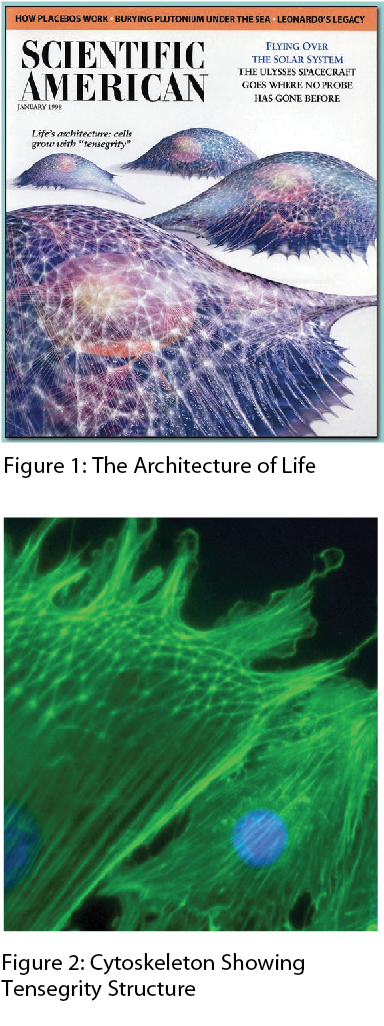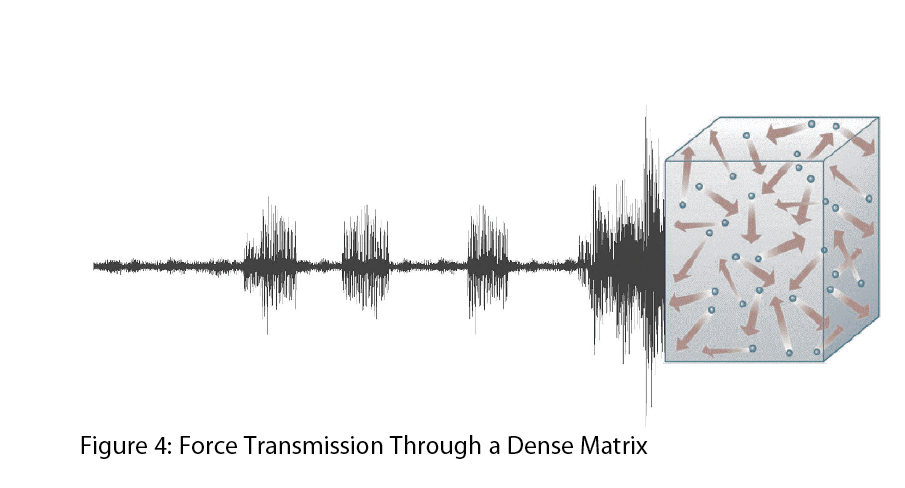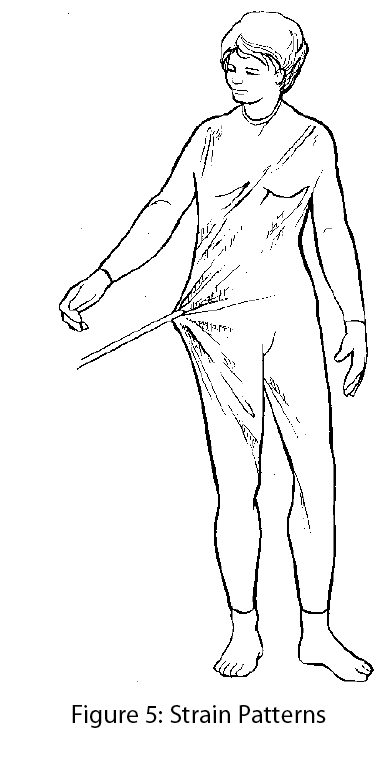
Features
Practice
Technique
Matrix Repatterning
As many clinicians have realized, diagnosis and treatment based on the area of symptoms, is often frustrating and fruitless, as it acts only on the peripheral effects of the primary condition.
August 20, 2010 By George B. Roth BSc DC ND

|
|
 |
|
| Figure 3: Normal and Restricted Tensegrity Structure | |
 |
|
| Figure 4: Force Transmission Through a Dense Matrix | |
 |
As many clinicians have realized, diagnosis and treatment based on the area of symptoms, is often frustrating and fruitless, as it acts only on the peripheral effects of the primary condition.
Symptoms, especially in chronic conditions, are often the result of the compensatory tensions and stresses created within the body in response to a primary site of tissue injury. Unfortunately, the primary lesion is often asymptomatic after the acute phase, as the brain adapts to the original injury as continuous background stimulation. This is what occurs, for example, with the fracture of a bone in the leg. Shortly after the cast is applied there is a significant reduction of pain in the immobilized area. Within a few days, however, the person begins to experience pain and discomfort in other areas, such as the knee, hip, lower back or neck, as these structures attempt to compensate for the loss of mobility originating in the immobilized limb. The resulting altered range of motion creates patterns of strain in the secondary sites, resulting in abnormal movement and inflammation. These secondary sources of painful stimuli tend to be intermittent in nature, and may therefore be perceived at a higher priority within the central nervous system, thus rising to a more conscious awareness of pain.
The challenge to the practitioner has historically been the ability to uncover the sources of primary injury. Symptoms are often elusive and changeable. The renowned author of Physical Medicine, Karl Lewitt, MD, has said it best: “He who treats the area of symptoms is lost.” Thus the need to objectify and delineate the underlying causal level of imbalance within the structure of the body. Where, in fact, does the underlying level exist? Is it in the muscles, the fascia, the joints, the nervous system? Or, perhaps at an even deeper level.
Matrix Repatterning is a revolutionary manual approach that addresses the primary sources of tension, which have been found to originate at the cellular and the molecular levels. This approach addresses the profound effects of injury at this level, which influence the entire connective tissue-fascial system and literally every cell and system in the body. It incorporates objective and reproducible methods, based on a new, proven model of structural pathophysiology. Treatment is gentle, painless and effective, and can often result in global reorganization and postural stabilization, encouraging the body towards normal, pain-free function. It is currently in use by physical therapists, chiropractors, physicians, osteopaths, athletic trainers, massage therapists and veterinarians on six continents and 12 countries around the world.
The Tensegrity Matrix
Matrix Repatterning is based on a new model of the underlying structure of organic tissue – the Tensegrity Matrix – which explains the complex interrelationship of all the structural components of the body. It extends the basic concept of the tissue response to injury, beyond the level of joint, muscle and ligament, to include all structures of the body as potential sources of dysfunction.
“The word ‘tensegrity’ is an invention: a contraction of ‘tensional integrity’. Tensegrity describes a structural-relationship principle in which structural shape is guaranteed by the finitely closed, comprehensively continuous, tensional behaviors of the system and not by the discontinuous and exclusively local compression member behaviors. Tensegrity provides the ability to yield increasingly without ultimately breaking or coming asunder,” writes Buckminster Fuller.1
The tensegrity matrix model of the body, as elaborated by Stephen Levin, MD2 and Donald Ingber, MD, PhD 3, holds that the body tissues are composed of interconnected tension icosohedra (complex triangular trusses), which inherently provide a balance between stability and mobility.
This structural model explains many of the observed phenomena related to body support, movement, response to stress and trauma, as well as the effects of therapeutic interventions. This theory has been verified by several studies in recent years. According to Ingber, a key investigator who has proven the existence of this structural model at the cellular level, the principles of tensegrity apply at essentially every detectable size scale in the human body. At the macroscopic level, the 206 bones that constitute our skeleton are pulled up against the force of gravity and stabilized in a vertical form by the pull of tensile muscles, tendons and ligaments. In other words, in the complex tensegrity structure inside every one of us, bones are the compression struts, and muscles, tendons and ligaments are the tension-bearing members.3
Primary Restrictions
When the force of an injury, either strain or impact, enters the body it is rapidly transmitted throughout the tensegrity matrix and thus throughout the body. Moderate forces are easily dissipated due to the elastic properties of the matrix. Excessive force, however, beyond a certain threshold, may be absorbed by the matrix, causing the molecular elements to be raised to a higher energetic state (see Figure 4). When force is transmitted through the tissues and encounters a dense surrounding material – such as water or bone – the energy may become even more focused and trapped locally. This focusing of force (or energy) is illustrated by the circle in the centre of Figure 4. The small black dots represent the increased concentration of molecules inside a dense structure, such as an internal visceral organ or bone. This focusing effect is like a magnifying glass that tends to concentrate the mechanical energy of a strain or an impact into the molecular elements of the matrix, within or surrounding the dense ground substance.
Water is the most dense substance in the body. Fluid-filled internal organs (such as the heart, liver, spleen and kidneys) and crystalline bone, due to its density, tend to absorb much of the force of injury. It has been our experience that these tissues are often the sites of primary restriction in otherwise resistant cases. Patterns of tension arising from these primary restrictions create aberrant motion and strain in structures throughout the body. This, in turn, results in disturbed biomechanics and an increased degree of stretch on pain sensitive structures such as joints and fascial tissues. The primary restriction itself is often painless after the acute phase and only becomes painful upon direct stimulation (tender or trigger points). The resulting strain patterns are illustrated in Figure 5.
Assessment
The goal of the assessment is to precisely locate the primary restrictions. This process relies on the interlinked nature of the entire fascial structure of the body. A primary restriction in one location will transmit a certain amount of tension throughout the entire body, producing a background level of tension we refer to as the tissue barrier. Changing the primary restriction should, in turn, change the tissue barrier.
An important feature of tensegrity matrix is that the normal and the restricted structural states are accompanied by different electronic properties, resulting in slightly altered electrical fields. Superimposing a normal electrical field over the abnormal field within the primary restriction will tend to shift the second field toward normal. This phenomenon, referred to as entrainment,4 would have the effect of temporarily restoring normal molecular tension within the primary site, thus reducing the resistance of the tissue barrier of the entire body. This may be felt as an increased compliance in another part, for example the rib cage or a muscle belly. Thus, by monitoring the tissue barrier at one location, the practitioner is able to systematically scan the entire body for the precise locations of each of the primary restrictions.
Treatment
Matrix Repatterning incorporates several specific manipulative techniques.5 A gentle, gradual pressure, referred to as induction, or a sudden movement, referred to as directional recoil, may be utilized. The principle of treatment is the release of fascial restrictions at the molecular level. It has been demonstrated that gentle compression of tissues results in a piezo-electric effect.6 This causes electrons, associated with the chemical bonds in the involved tissues, to generate a form of intrinsic current. This effect has been demonstrated in bone repair and occurs when it is placed under compression. The resulting flow of electrons may allow the excess stored charge within the restricted molecules to discharge, in the same manner as a capacitor releases excess energy.
Treatments are generally painless and work in harmony with the body’s healing processes. Matrix Repatterning practitioners utilize specific, objective tests to monitor the effectiveness of treatment. Significant abnormal findings in ranges of motion and other functional tests are used as a baseline reference for structural change. The result of acting on the primary foci can be readily observed in the often dramatic and immediate changes, which occur upon re-examination.
For more information about Matrix Repatterning, please visit www. matrixrepatterning.com.
References
- Synergetics, RB Fuller, MacMillan, New York, 1975.
- The Importance of Soft Tissues for Structural Support of the Body, SM Levin, In: Positional Release Therapy: Assessment & Treatment of Musculoskeletal Dysfunction, K D’Ambrogio & GB Roth, Mosby-Elsevier, St. Louis, 1997.
- The Architecture of Life, DE Ingber, Scientific American, Vol. 1, 1998.
- Energy Medicine, The Scientific Basis, JL Oschman. Churchill Livingstone, New York, 2001.
- Matrix Repatterning, The Structural Basis of Health, GB Roth, Wellness Systems Inc., Toronto, 2001.
- Streaming and piezoelectric potentials in connective tissues. LA MacGuintie, In: Blank M (ed) Electromagnetic fields: biological interactions and mechanisms. Advances in Chemistry Series 250. American Chemical Society, Washington DC, ch. 8, pp 125-142, 1995.
Dr. George Roth, the originator of Matrix Repatterning, has been involved in the study and development of advanced health-care systems for over 30 years. He is a published author and has lectured extensively at universities, physical medicine symposia and clinical workshops.
Print this page